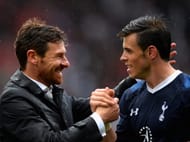When Roman Abramovich burnt a huge hole in his heavy pockets to bag the services of Andre Villas Boas, there was a feeling of consensus in the footballing world that Chelsea were looking towards a long term project. After all, Villas Boas had just won the Europa League with FC Porto, a team he had transformed into a blitzkrieg of an attacking unit, backed formidably by a balanced midfield and a compact defence.
Abramovich’s vision, perhaps, was along similar lines. After all, who better to head the transition than the man who had done it before? Unfortunately for Villas Boas, the rivers of patience ran dry at the Bridge, as a run of bad results overshadowed the time required for a project of that magnitude.
Fast forward a few months, and the idea of the Porto project at White Hart Lane seemed plausible and feasible. Spurs had no compelling pressure to win trophies on a consistent basis, and with only a top 4 agenda to fulfill, the spotlight was far less blinding than that at Chelsea. Hence began Tottenham’s transition under Andre Villas Boas.
Villas Boas came to White Hart Lane at the end of a heart wrenching campaign for Spurs, as Chelsea’s Champions League triumph robbed them of a spot in the Champions League, in spite of a well earned 4th place finish. Harry Redknapp’s reign as manager had seen Spurs exceed expectations, where they mounted a fight for the top 4 and qualified for the Champions League for the very first time in their history (2009/2010).
Once again, Villas Boas inherited a squad which needed to undergo a makeover of sorts, to effectively challenge for the top 3. In his one season in charge, AVB’s tenure showed much promise, more so for Tottenham fans looking to win the bragging rights in North London. Below we take a look at just how Villas Boas has aided Tottenham’s transition, and why next season could be a breakthrough for both club and manager.
Gareth Bale and Spurs’ tactical evolution
To know just how Gareth Bale has progressed as a player, it is important that we start at the very beginning. As a young 17 year old, Bale was plying his trade in the Championship for Southampton. The youngster put in some very impressive performances, remarkably similar to the ones being put in by another young left back from Southampton by the name of Luke Shaw. Exceptionally agile and with a gem of a left foot, Bale was eventually linked with many Premier League sides like United and Arsenal, but was eventually bought by Spurs.
Bale’s initial performances suggested anything but the fact that Spurs had a world class prospect in their ranks. He struggled to adapt to the rigours of the Premier League, and was quietly relegated to second choice left back behind the more industrious Benoit Assou-Ekotto. According to rumours circulating back then, Spurs offered Bale to Birmingham for 3 million GBP, a move which Birmingham rejected.
His lucky break came towards the end of the 2009/10 season, with Spurs reeling under the pressure of injuries to multiple key players, which threatened to derail their Champions League hopes. This development forced Redknapp to play Bale in a left midfield role, a move which suited him well. In the second North London derby of the season in April, Bale made his presence felt as he grabbed the winner, scoring after a through ball from Jermaine Defoe. The week after, he grabbed the spotlight once more, as he bagged the winner against league leaders Chelsea. He ended that rich vein of form by scoring against Burnley in their last league fixture of the season.
Bale’s playing style at that time was summed up by a game that was probably the highlight of his career, a 4-3 defeat against Inter Milan. After Spurs found themselves 4-0 down at half time, he produced a master class, scoring three times against one of the best right backs at that time, a tireless engine called Maicon. His willingness to run directly and fearlessly at the defender, trailblazing pace and excellent technique all shone brightly in all three goals, and he was now on his way to becoming one of the best players in the world.
Redknapp used Bale as a strictly left sided player in a rigid 4-4-1-1, supported in the centre by the distribution of Luka Modric and Aaron Lennon on the other wing. Rafael van der Vaart played behind the lone forward, linking the defence to attack smoothly with his intelligent movement and passing. Little did Redknapp know that the formation restricted Bale’s actual potential, as Van der Vaart’s presence in the middle constrained Bale onto the wings, and drifting into the centre left the wing exposed. Also, if Bale did drift inside, it would leave him, Van der Vaart, Modric, Parker and Crouch/Defoe/Adebayor in the centre, in essence congesting the centre of the pitch.
To solve this dual conundrum of lack of freedom to Gareth Bale and the flawed dynamics of the Redknapp system, AVB experimented with a variety of options. He recognised the two inherent flaws in the side – one, that Bale’s accurate shooting and blistering pace were being underutilized on the left wing, and two, that if Bale was brought into the centre, Tottenham’s tactical shape and balance collapsed, as Bale became more of an inside forward/support striker, which also disrupted Van Der Vaart’s not-so-versatile playing style.
So Villas Boas started by restructuring his team altogether, and this new phase of Tottenham’s evolution was marked by the departures of arguably two of their most influential and important players – Luka Modric and Rafael Van der Vaart. AVB decided to fill those vacancies by buying three players with very different playing styles – Moussa Dembele, an attacking midfielder (a position that cannot be used in a 4-4-2), Clint Dempsey and Icelandic midfielder Gylfi Sigurdsson.
AVB started the season by playing a 4-2-3-1, using Bale as a left sided attacking midfielder, which was a more advanced position than his left midfielder position under Redknapp. Sandro’s defensive resilience and Dembele’s ability to silkily bring the ball forward both helped in restoring the balance in Tottenham’s formation as well as giving Bale an added measure of freedom.
But as the season went by, Clint Dempsey’s less than satisfactory displays in centre attacking midfield and Sigurdsson’s inability to adapt to Tottenham’s system forced AVB to change the system once again. Instead of reverting back to the 4-4-1-1, AVB switched to a 4-4-2, putting Defoe and Adebayor up top. This meant that Bale was now back to his left midfield role, but the lack of an attacking midfielder allowed him the liberty to cut inside at will. The lack of coordination between Adebayor and Defoe led to yet another failed formation, but AVB’s decision to let Bale use the centre worked well.
He capitalised on the benefits of that move, shunting Bale inside, and asking Gylfi Sigurdson to move on to the outside. This resulted in Bale’s finest run of form, as he went on to score 11 times (assisting 4) in 13 games. But this system too had its limitations. Bale could easily be crowded out by committing bodies in the centre. Also, Bale’s shift towards the centre meant that AVB could no longer shift to a 4-3-3 during games, a formation he has been fond of since his days at Porto.
He had tried to enforce a 4-3-3 at Spurs as well during the start of the season, but because they lost key transfer targets (a deal for Joao Moutinho fell through on the final day, Oscar was snapped up by Chelsea), the tactic could not be implemented properly. This forced AVB to make yet another change, signalling another step in Tottenham’s tactical evolution. He did this by moving Bale to the right wing, and shifting Gylfi Sigurdsson into Bale’s old position at left wing.
Bale used this new position to devastating effect, cutting in regularly onto his stronger foot and unleashing venomous strikes. His goals against Manchester City, Wigan and Southampton all came from the right side of the pitch, as he finished the season in this position.
Overall, AVB’s experiments with Bale and Tottenham produced mixed results. Even though Tottenham missed out on Champions League qualification, Gareth Bale ended up winning the PFA Young Player of the Year and the PFA Player of the Year awards. Although the footballing fraternity praised Gareth Bale for maturing as a world class talent, AVB’s contribution in making him brilliant lay intertwined in commendable footballing logic.
Preparing for the 4-3-3
Although Spurs finished decently enough, the fact of the matter was that CL qualification had eluded them for the second year running. In the close season though, AVB has been hard at work to correct his mistakes from last season, starting from getting his preferred formation, the 4-3-3, up and running.
After seeing that Bale had fit excellently into his role on the right wing (alarmingly similar to the role the left footed Hulk played in his Porto side), he worked on getting the other aspects right. After losing out on a world class midfielder to play in the centre of his 4-3-3, he splashed the cash on one of the most exciting talents in the Brasilerao, as Paulinho arrived at White Hart Lane for 17 million GBP.
Paulinho, a box to box midfielder, offered an excellent all-round option in the formation, and on paper looks like an intelligent buy. Paulinho’s devastating aerial prowess aside, he offers a powerful presence in midfield, combining a resolute defensive presence with lung-bursting runs into the box. What Paulinho’s signing also does is that it allows Dembele to move into his preferred attacking midfield position more often, as the defensive work is now taken care of by Paulinho himself and the other midfielder, who could be either Sandro or Scott Parker.
The other flaw AVB recognised was that Gylfi Sigurdsson on the left wing wasn’t really an enticing prospect. In a system which relied on counter-attacks being initiated from the wings, Sigurdsson was found wanting on several occasions. Hence, to compensate for the lack of pace on the wing, Tottenham agreed to sign Nacer Chadli, a pacy winger who will fill in some of the gap left by Bale’s destructive wing play.
Considering that Tottenham’s forwards were not too impressive last term, AVB has been quick to delve into the transfer market for good options. Christian Benteke might have slipped out of their hands, but their long standing interest in Internacional forward Leandro Damiao and the recent talks with Valencia striker Roberto Soldado are massive statements of intent from the Tottenham manager.
Everything being said, Tottenham look well and truly on their way to making a strong team for the upcoming campaign. Whether Tottenham adapt well to the 4-3-3, or if Bale’s run of form continues, are questions which will make Tottenham an intriguing watch come August.


